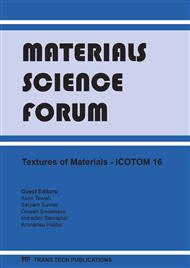p.374
p.378
p.385
p.391
p.398
p.402
p.406
p.411
p.415
Effects of Initial Parameters on the Development of Cube Texture during Recrystallization of Copper
Abstract:
A series of oxygen free high conductivity copper samples with different initial grain sizes, cold rolling conditions and storage times as well as slightly different impurity contents was used to investigate the effects of these initial parameters on the development of cube texture during recrystallization. For rolling reductions of 90% and 95%, cube textures with volume fractions between 3% and 50% were observed. Higher rolling reduction led to a stronger cube texture. Cube texture development is very sensitive to the initial grain size before rolling. In general, fine grained material gives a strong cube texture after recrystallization, and the requirement on fineness of the grain size may vary for materials with different purity. Large sample widening during rolling can largely inhibit the development of cube texture after recrystallization. Neither storage time, nor the slight change in impurity content had large effects in the present investigation.
Info:
Periodical:
Pages:
398-401
Citation:
Online since:
December 2011
Authors:
Keywords:
Price:
Сopyright:
© 2012 Trans Tech Publications Ltd. All Rights Reserved
Share:
Citation:


